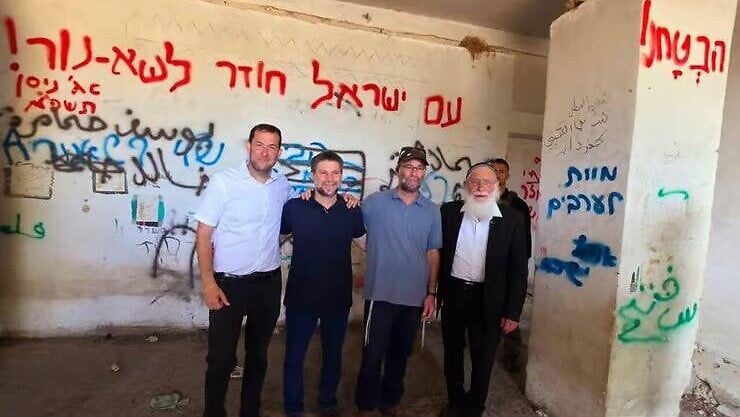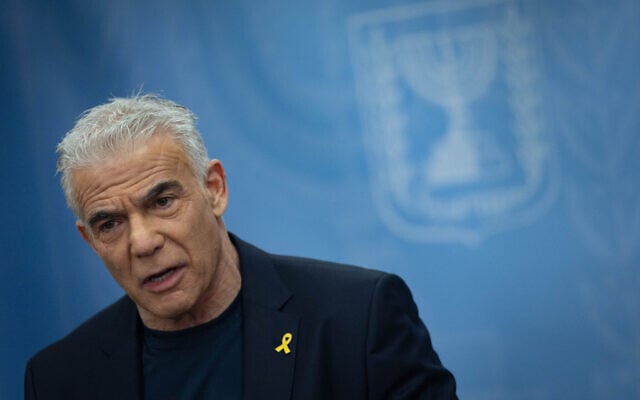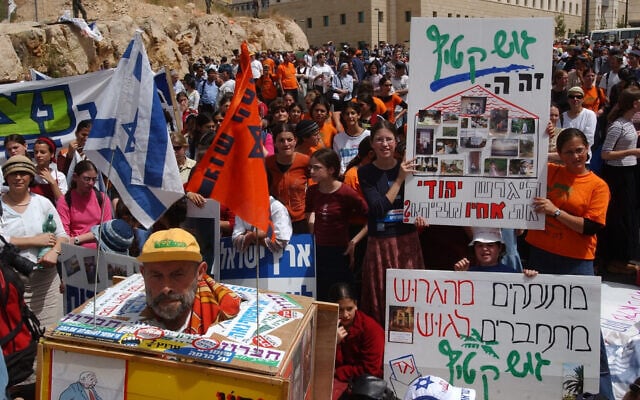Finance Minister Bezalel Smotrich on Thursday disavowed the slogan “Death to Arabs” after being photographed next to the graffitied phrase during a tour of the northern West Bank, in which he vowed to rebuild the settlement of Sa-Nur that was evacuated decades ago.
Smotrich, who also serves as a minister in the Defense Ministry, was photographed next to the slogan as he visited the site to mark 20 years since it and the nearby settlement Homesh were dismantled as part of Israel’s 2005 Disengagement Plan. The plan also saw Israel evacuate the Gaza Strip’s Gush Katif settlement bloc, which Smotrich has called on Israel to rebuild as well amid the war in Gaza.
Following online criticism of the photograph, Smotrich’s office said in a statement that the offending phrase was noticed only “after the photo was distributed, and of course we completely disavow it.”
Smotrich’s office said the media shouldn’t be concerned by “stupid graffiti that no one noticed,” but by the minister’s drive to “reverse the expulsion from northern Samaria and resettle Sa-Nur.”
The photograph was included in a press release by the Samaria Regional Council, which oversees settlers’ municipal affairs in the northern West Bank. Council head Yossi Dagan, who also appeared in the photo, later sent out a second press release with the “Death to Arabs” graffiti cropped out of the picture, without apologizing for the phrase or explaining the reason for the edit.
Get The Times of Israel’s Daily Edition
by email and never miss our top stories
By signing up, you agree to the terms
Opposition Leader Yair Lapid slammed Smotrich on X: “Aside from the moral issue, what in God’s name does the government expect us to say to the world when a photo is published of a senior minister smiling next to the inscription ‘Death to Arabs’?”
Opposition Leader Yair Lapid leads a faction meeting at the Knesset, in Jerusalem, on August 4, 2025. (Yonatan Sindel/Flash90)
Smotrich’s appearance next to the slogan — a fixture of some right-wing gatherings — came as settler attacks on Palestinians in the West Bank have taken place on a near-daily basis, largely with impunity, sparking mounting sanctions from Western governments.
‘Correcting the mistake of the expulsion’
Visiting the former area of Sa-Nur with families who said they were preparing to move there, Smotrich, referring to the 2005 Disengagement, said: “We are correcting the mistake of the expulsion.”
“Even back then, we knew that… we would one day return to all the places we were driven out of,” said Smotrich. “That applies to Gaza, and it’s even more true here.”
The Palestinian Authority issued a strong condemnation of Smotrich’s visit, saying it was part of “plans to entrench the gradual annexation of the West Bank, posing a direct threat to the possibility of implementing the two-state solution” to the Israeli-Palestinian conflict.
Illustrative: Residents of the Gaza Strip settlement bloc Gush Katif protest against Israel’s Disengagement Plan on May 30, 2004, outside of the Prime Minister’s Office in Jerusalem. (Flash90)
In a statement, the PA foreign ministry said the push “to revive settlements that were evacuated 20 years ago” would lead to further confiscation of Palestinian lands.
Defense Minister Israel Katz confirmed in May that Israel had approved the construction of 22 new West Bank settlements, including Sa-Nur and Homesh.
Israeli NGO Peace Now, which monitors settlement activity in the West Bank, said some of the 22 settlements the government announced as new had already existed on the ground.
Some are neighborhoods that were upgraded to independent settlements, and others are unrecognized outposts given formal status under Israeli law, according to Peace Now.
Defense Minister Israel Katz meets with IDF officials at the site of the former Sa-Nur settlement in the West Bank after the government approves its reconstruction, May 30, 2025. (Ariel Hermoni/Defense Ministry)
Israeli settlements in the West Bank, which Israel has controlled since the Six Day War of June 1967, are considered illegal by most of the international community, with the exception of the United States.
Settlements in the West Bank are seen as impeding the establishment of a Palestinian state there, in the Gaza Strip and East Jerusalem as part of the two-state solution.
Smotrich and others in Israel’s right wing have rejected Palestinian statehood and called for Israel to annex the West Bank, which is home to an estimated three million Palestinians and 500,000 settlers.
Is The Times of Israel important to you?
If so, we have a request.
Every day, even during war, our journalists keep you abreast of the most important developments that merit your attention. Millions of people rely on ToI for fast, fair and free coverage of Israel and the Jewish world.
We care about Israel – and we know you do too. So today, we have an ask: show your appreciation for our work by joining The Times of Israel Community, an exclusive group for readers like you who appreciate and financially support our work.
Already a member? Sign in to stop seeing this
You appreciate our journalism

You clearly find our careful reporting valuable, in a time when facts are often distorted and news coverage often lacks context.
Your support is essential to continue our work. We want to continue delivering the professional journalism you value, even as the demands on our newsroom have grown dramatically since October 7.
So today, please consider joining our reader support group, The Times of Israel Community. For as little as $6 a month you’ll become our partners while enjoying The Times of Israel AD-FREE, as well as accessing exclusive content available only to Times of Israel Community members.
Thank you,
David Horovitz, Founding Editor of The Times of Israel
Already a member? Sign in to stop seeing this



